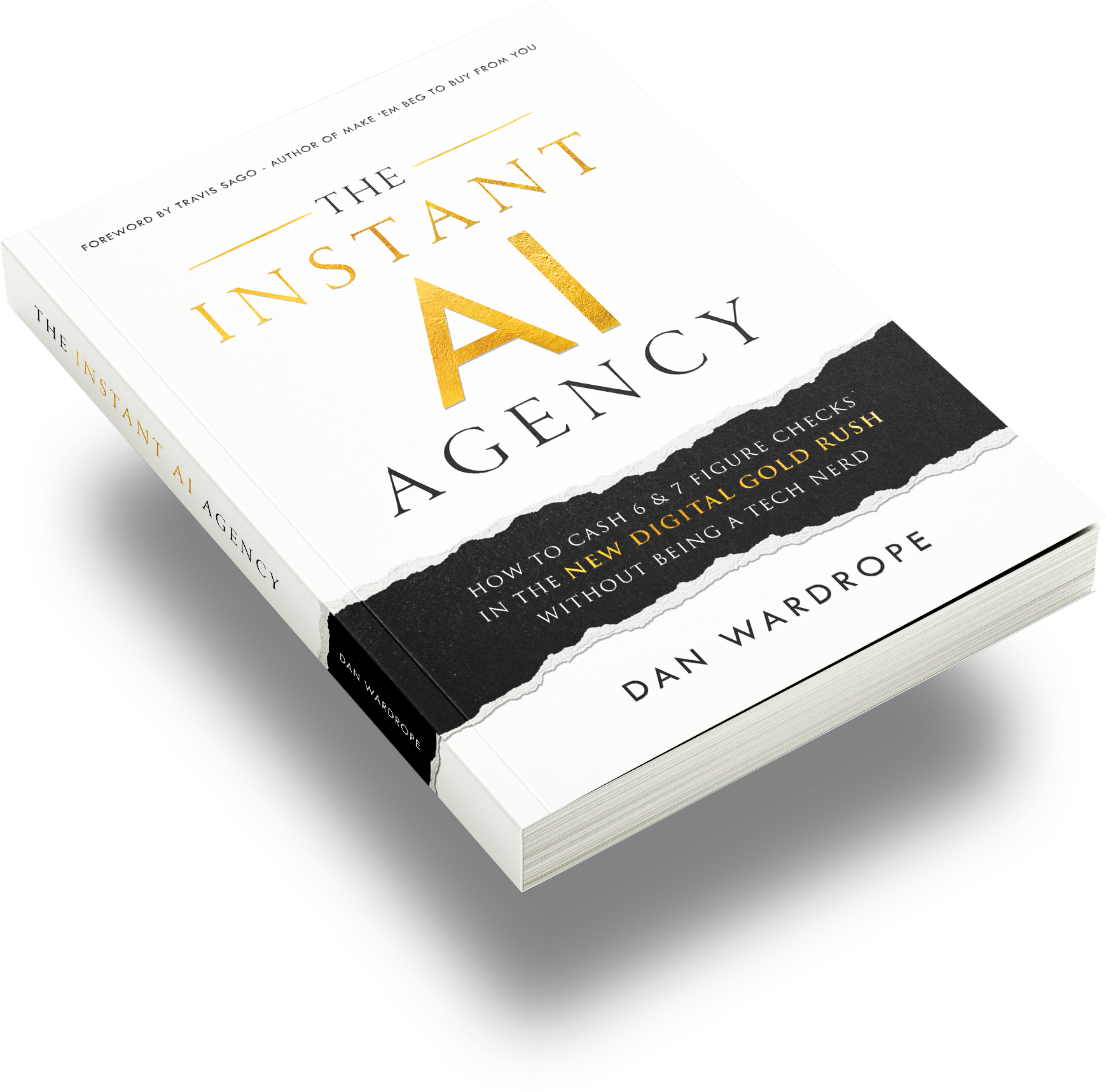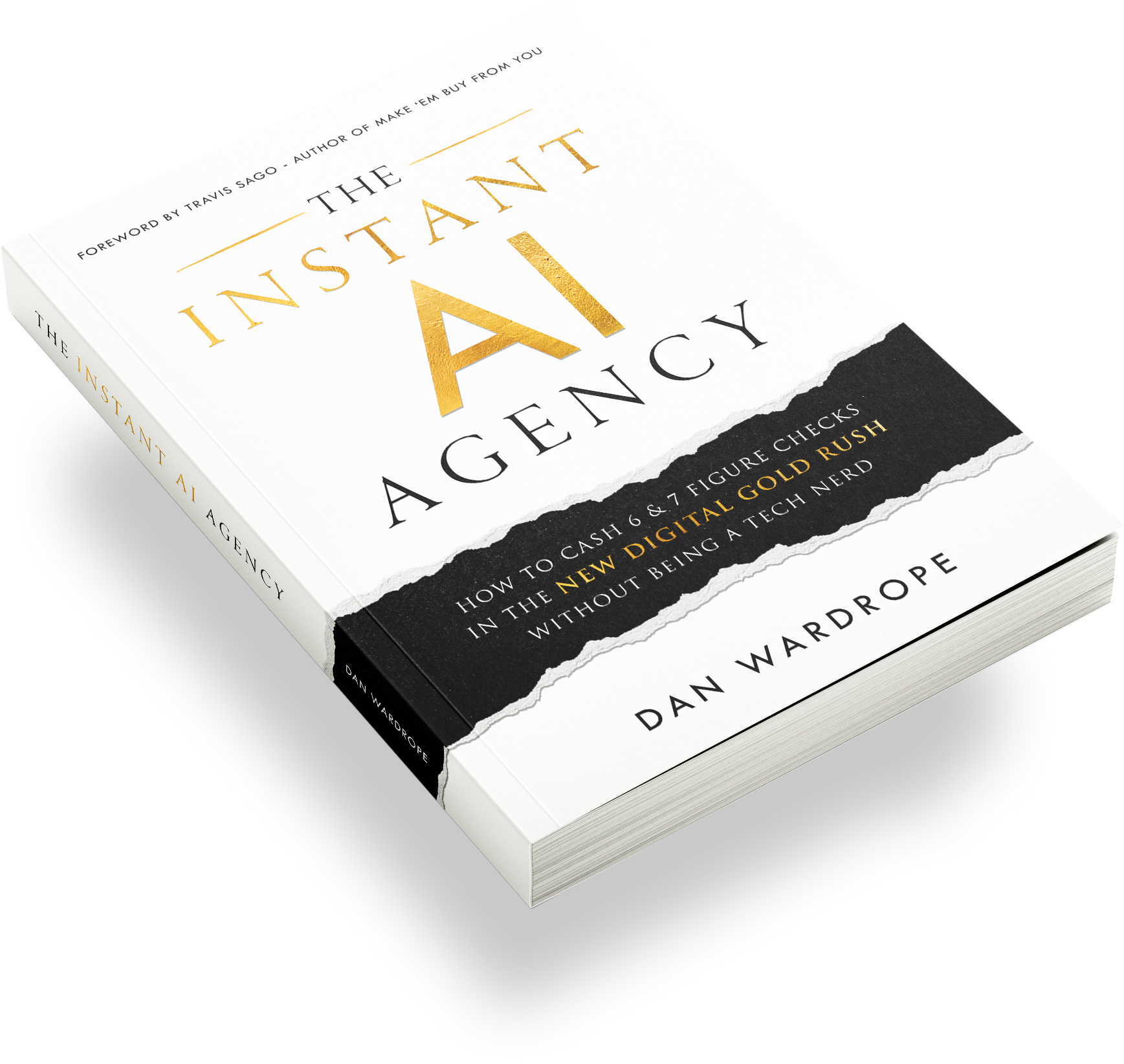Bonus Material: The Pay Per Lead Quick Start Guide
[maxbutton id=”1″ extraclass=”quickstartguide” ]
For lead generation agency owners, starting in a new niche can be a daunting task.
If you’ve got years of experience running an agency, I always recommend the same thing: stick with what you know. You’ll have an understanding of the industry, know the customers you want to target, and will have a good idea of what works in a sales funnel and what doesn’t.
However, some of you reading this won’t have years of experience in lead generation, and that’s okay.
Some of you will be working with “local clients” (doctors, gyms, dentists) and will be looking for a way to grow and scale your agency. I.e. looking for industries that have a national appeal and clients with big pockets.

Wrong!
Your competition didn’t reinvent the wheel.
They didn’t waste precious time trying to be 100% original (and then crying themselves to sleep when they realised their strategy didn’t work).
Your competition got where they are today by borrowing and improving the sales funnels other agencies made before them.
When you’re running paid traffic, you don’t have time to mess around. You’ve got to get it right (or right enough) the first time. And, with some clients, you have about 7 days to prove your worth.
Being a master of any field means learning from the people who came before you.
So, today I’m going to show you how to reverse engineer your top competitors in the roofing industry. BUT, you can use this technique and apply it to any niche in the lead generation space.
|
Bonus: If you’re worried about getting clients with deep-pockets, never fear. Part of my bonus package includes how to land national level clients that will buy 100’s of leads per day from you, using our cold email formula. Plus the exact YouTube ad script template I use to drive millions of views and thousands of leads at FlexxDigital. You can access this all for free inside my Pay Per Lead Quick Start Guide.
|
[maxbutton id=”1″ extraclass=”The Pay Per Lead Quick Start Guide” ]
Now, let’s jump in. But first:
Why The Roofing Niche?
The roofing niche can be incredibly profitable for PPC agency owners.
I have many students in the Pay Per Lead Agency Blueprint who have excelled in the roofing industry.
One in particular, who shall remain anonymous (sorry) is spending $10k a day on ad spend in this space.
He’s currently on a hybrid deal, which is excellent for beginners in a niche.
In this kind of deal, the client pays for the advertising spend. Say, for example, they are willing to spend $20,000 for the week. For that amount, you would run ads and try to generate as many leads as you can.
If the client manages to close any leads, you’ll get a fee. So, if they close 500 leads, they could pay you $100 per close. For you, that’s $50000 profit.
This is a sweet deal, as your money isn’t on the line. If those leads don’t convert, you haven’t squandered thousands of dollars.
My student tells me that the same hooks that were working in roofing are still working now. I.e.:
- 0% interest/no money down
- Storm damage
- Insurance/government incentives etc.
Better yet, once he’s seasoned his pixel, interest targeting on Facebook isn’t required. Because of rising CPM costs, leads can cost anywhere between $10 and $40 to generate. However, he doesn’t have to spend hours creating new audiences and separating his ads for different devices – aka mobile, tablet, etc.
However, successful though my student is, there are still several things he’s not doing or hasn’t tried.
- He hasn’t built a proper lead gen brand, such as a lead generation website.
- He doesn’t use advertorial sales funnels
- There’s no lead segmentation or cross-selling
- He puts all his eggs in the “Facebook” basket. Read this article here to see why that’s a mistake.
- He hasn’t created a lead magnet.
I’m not telling you this to put my student down. He’s been incredibly successful using the simple funnel system and old hooks that he’s using now.
What I’m saying is this: imagine if he spent a bit of time reverse engineering his competitors and implemented the above into his current strategy.
His agency work would go from “successful” to absolutely off the scale.

And I’m going to show you how to go “off the scale” today.
Join me as I reverse engineer one of the US’s top lead generation businesses in the roofing industry.
I’ll pull their entire sales funnels apart and show you exactly what they’re doing in the roofing space.
Then, even better, I’ll tell you exactly how they could improve it – and what to do to get ahead of the competition.
So…
What Is Reverse Engineering?
Reverse engineering is when you take an object or idea and pull it apart to see how it works. Then, once you understand it, you attempt to build a similar or enhanced version for your own gain.
Remember when you had to write an essay at school? The teacher would usually hand out a “model” essay to analyse and understand why it received the top marks.
You’d then take a leaf out of that model student’s book, and try to recreate your own essay that was as good, if not better.
Though you didn’t know it at the time, that was a classic example of reverse engineering.
So, when you’re building sales funnels for a client, there’s no need to reinvent the wheel (to begin with). Do your research by checking out your competitor’s sales funnels, and make note of what they’re doing well and what you could do better.
When it comes to building your own sales funnels, use that knowledge to create something that blows the competition out of the water. Reverse engineering saves you a ton of time, a ton of energy, and the results are usually far better than when you struggle to come up with something “100% original”.
What Tools Can I Use For Reverse Engineering?
1. AdvertSuite
2. Facebook Page Transparency/Facebook Ads Library
AdvertSuite
There is a range of tools you can use to reverse engineer your competitors, but we use AdvertSuite at Flexx Digital.
AdvertSuite is the “world’s largest database of Facebook ads” that can show you “all current live and past Facebook ads that are winners in any niche”. You can also take a look at some ads’ “targeting countries, group ages, marital statuses” and any other key demographics that make the ads truly WORK.
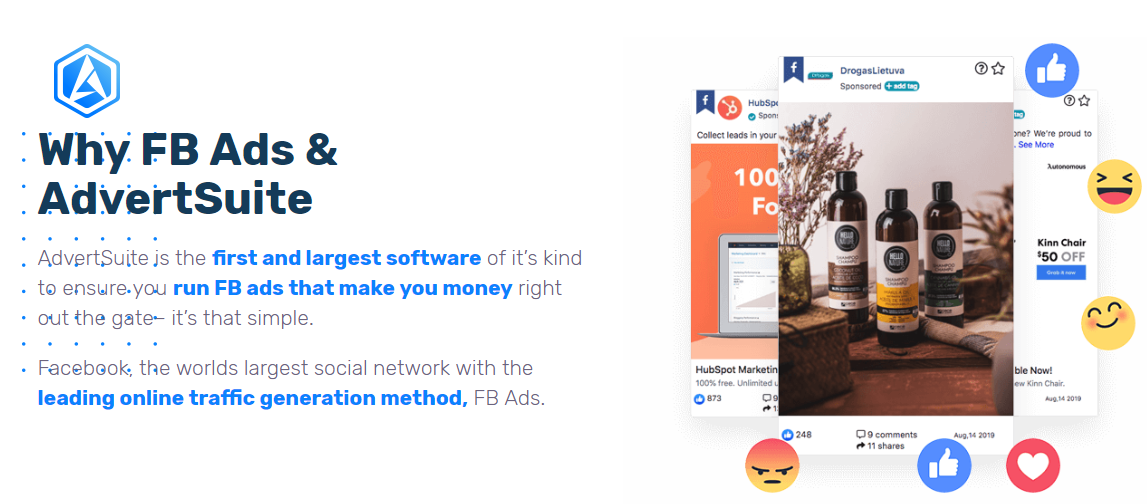
For a basic fee of $67, you can have over 40 million Facebook ads at your fingertips.
Even better, for an extra $57, you can get millions of Instagram, Google Search and YouTube ads.
Features include:
- Being able to see the best performing ads on Facebook, Instagram, YouTube and Google Search in any industry
- Unlimited searches, bookmarks and usage
- Competitor breakdown – your main competitor’s ads and landing page
- Demographic and engagement filters
- Geolocation filters
- Video and image ad integration
- Ad engagement, Likes, Comments and Shares.
This is what AdvertSuite looks like:
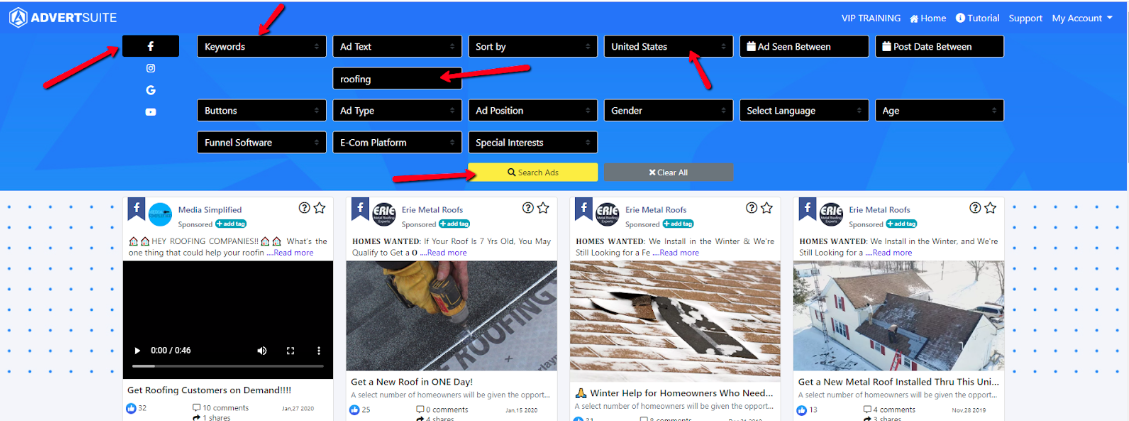
To find the main competitors in your niche, type in your keywords into the box marked “Keyword Type”. Click the box and select “Ad Text”.
Another box will appear, “Enter Ad Text”. Write your keyword in here. For the purposes of this article, I’ve used the keyword “Roofing”.
Next, select the country you’d like to view ads from. As you can see, I’ve gone for “United States”.

You can make your search as broad or as granular as you’d like. AdvertSuite also offers searches such as “Ad Type” (photo or video), Ad Position (news feed or side column), Gender, Language, Funnel Software (ClickFunnel or LeadPages); the list goes on.
For this particular “deep dive”, I kept my search terms pretty broad. I looked up “Roofing” as a keyword, opted for “United States” and specified that I wanted ads with the most Likes, Comments and Shares.

I’ll get onto what I found later on, with my sales funnel deep-analysis.
If (for whatever reason) you don’t want to use AdvertSuite OR you want to use a complimentary program, you can opt for the following:
- PowerAdSpy (find out its pricing details here)
- AdSwiper’s Facebook Ad Spy Tool (pricing details here)
- AdEspresso (find that here)
- Plain old Google search
Facebook Page Transparency/Facebook Ads Library
I usually use the Facebook Page Transparency tool alongside AdvertSuite.
Once you’ve used AdvertSuite to find your main competitor’s fan pages, search for the Facebook pages here
You can then see every single ad your competition are currently running.
Though you won’t be able to see any stats about the ads (demographics, likes or comments), Page Transparency is still a great way to see what ads your competitors are putting out there.
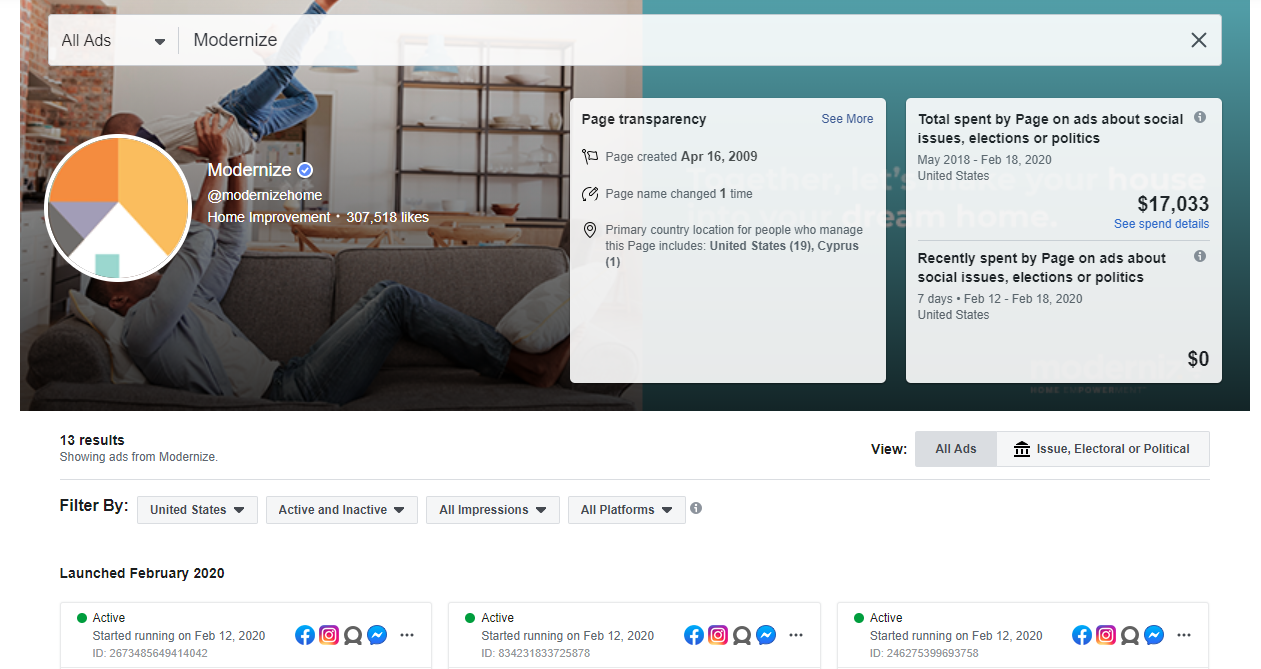
Google Search
Using Google is pretty self-explanatory.
Type your chosen keyword(s) into the search bar, and check out your main competitors from the top results.
But don’t just stick to the ads at the top of the page – studying organic content also has its place. After all, the top pages got to the top of Google search through excellent SEO and excellent content.
Modernize: A Deep Dive Into A Top Competitor In The Roofing Industry
5.General Notes About Modernize’s Roofing Ads
Discovering Modernize
After a quick search on AdvertSuite, a clear top competitor was called Modernize.
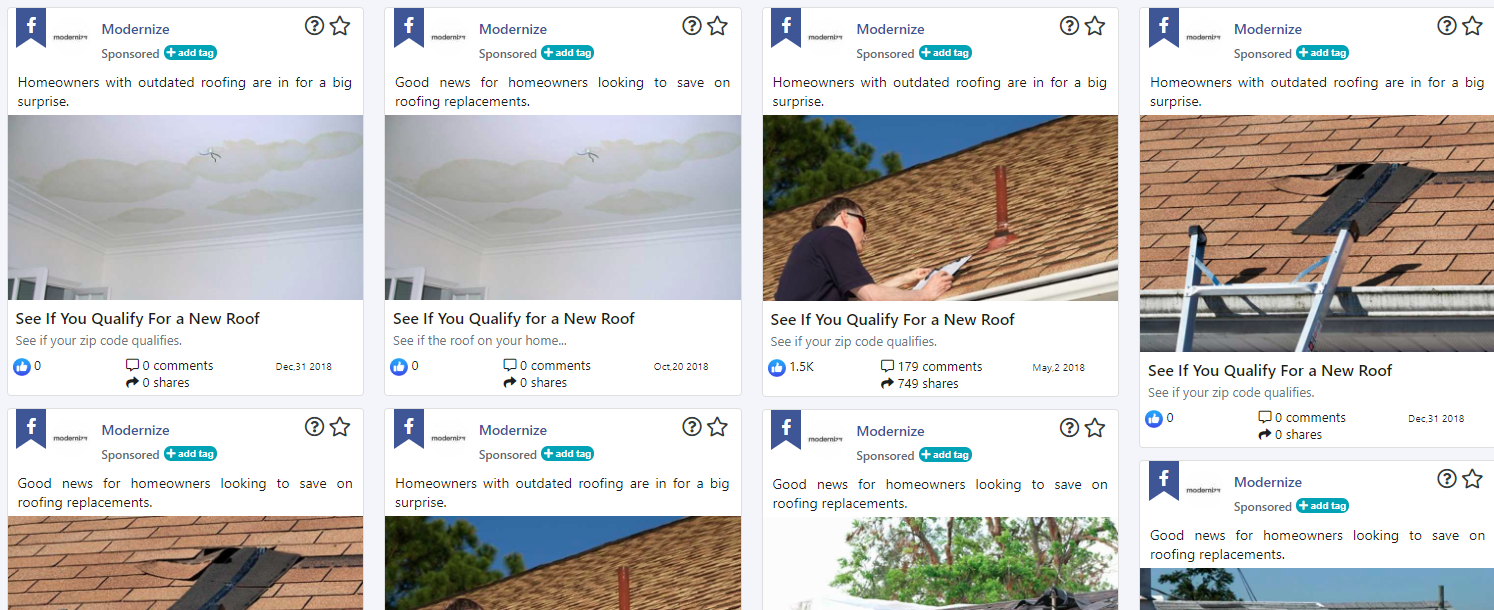
On AdvertSuite, their top-performing ad had 1.5k Likes, 179 comments and 749 shares.
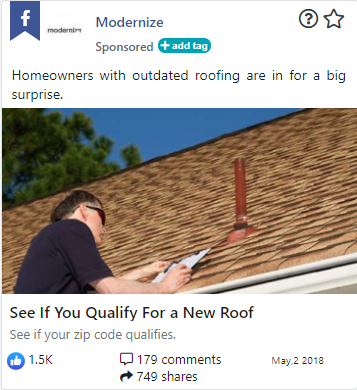
Clicking on the ad, you can see it was:
- Live between April and May 2018
- Targeting males between 35-44 in the United States
- Using an advertorial funnel – “Homeowners With Outdated Shingles in for Big Suprise.”
Then, clicking onto the advertorial, you can see the copy is relatively short.
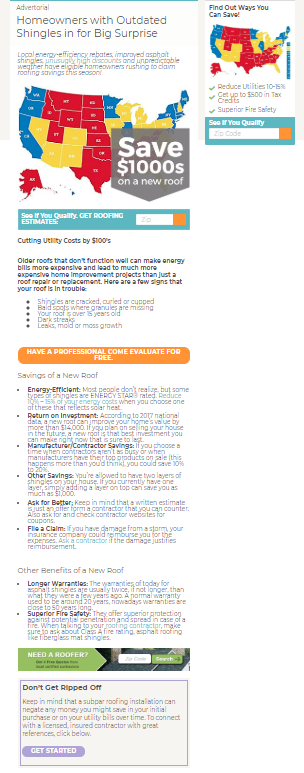
Modernize briefly sums up 6 financial benefits of having a new roof, gently leading the audience to its CTA.
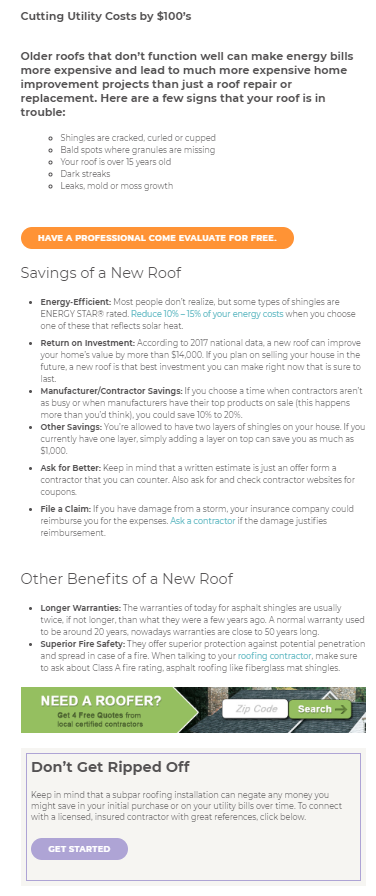
The advertorial’s main hook instantly becomes clear. The CTA proclaims: “Don’t Get Ripped Off”.
This relates to an interesting bit of psychology that Robert Cialdini explored in his book, “Influence: The Psychology of Persuasion”.
In any industry, it’s easy to fall into the “boring, same old hook” trap.
It’s lazy writing, and you’ll see it everywhere. Take the life insurance niche, for example:
“Life insurance quotes from £5 per month”.

It hardly sets you on fire, does it?
And audiences are so used to seeing “hooks” like this, we’ve learned to ignore them.
One tip for an “out of the box hook”, as Robert Cialdini tells us, is to think negative.
He then goes on to tell us about a study conducted with two slightly different adverts, sent to homeowners in the same neighbourhood.
The first ad said: “If you insulate your home fully, you’ll save 50 cents a day.”
The second said: “If you don’t insulate your home fully, you’ll lose 50 cents a day.”
The people who received the second ad were 150x more likely to insulate their homes.
This study shows us that people are more motivated by the fear of loss than the hope of gain. Avoiding pain is more important to our survival than gaining pleasure.
Modernize taps directly into this. Instead of appealing to pleasure (“see how much you can save on one of our roofs!”) they insinuate the possibility of massive loss (“Don’t get ripped off”).
I’ll talk more about developing hooks later on in the post.
Now that I had my main competitor, and I know they’re using advertorial and quiz sales funnels, I decided to check out their more recent ads using the Facebook Transparency Tool.
These are the ads I found:
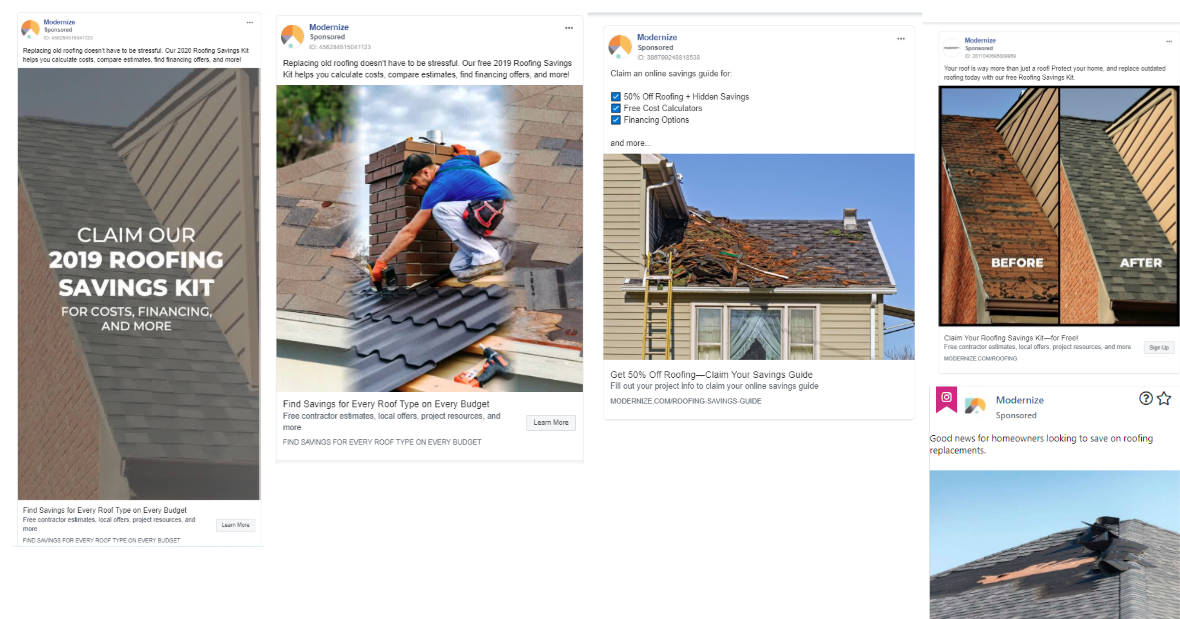
Modernize’s Use Of Images
The first thing I noticed was the Modernize’s use of images, like this one here:
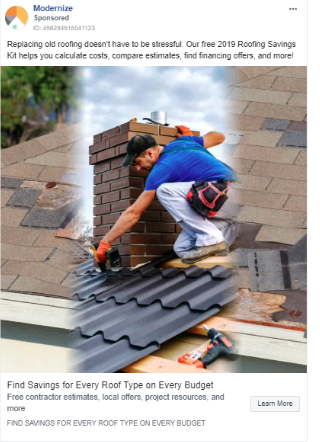
As you can see, these images are pretty “stock image” like. In fact, it didn’t take me long to find this one by typing “roofing” into Google and doing an image search.

This image is layered on top of another one (most likely another stock image), giving the ad an amateur look.
I then put “roofing before and after” into Google Image Search, and I found another image that looked remarkably similar (read: exactly the same) as the one used in the Modernize Before/After ad:
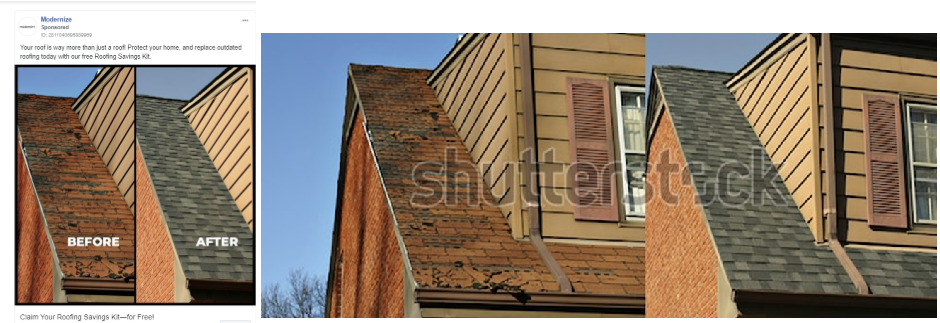
I’m not here to rip Modernize to shreds – their use of stock imagery is obviously working.
Although stock imagery has got a bad rap, it has its pros and cons.
Pros:
- It’s cheaper and quicker than a photoshoot. It can take weeks to coordinate a photoshoot. If you don’t have an in-house photographer or access to a decent camera, it can cost a pretty penny too. With stock photos, everything is done for you and ready to go.
- Stock photos are available immediately.
- They make their point, and the photos are of good quality. When people are looking for roofing services, they expect to see pictures of roofs. Why spend hundreds of dollars on a custom-made image, when the internet is full of cheaper photos that suit your needs?
Cons:
- Stock photos can be used by anyone. The goal of marketing is to stand out from the competition and get noticed. Shutterstock, a global provider of stock images, has 1.4 million users. That’s 1.4 million marketers drawing from the same bank of photos. You can guarantee that other roofing companies have used similar, if not the same, photos for their ads.
- Stock photos are cliche. They may tell you what the ad’s about, but they’re so familiar and boring, potential customers will just scroll on by. If you want to stand out, it may be worth investing in photos that are a little different.
- They lack authenticity. Imagine if all potential customers made a quick Google Image Search, as I did. Once they realise that all these photos have been downloaded off the net, trust in the company will drop. They want to believe that all these great-looking roofs are the direct result of the company’s hard work.
- Stock photos lower conversion. According to The Marketing Garage, an original photo can increase CTR by as much as 45%, in comparison to a top-performing stock photo. Turns out that the old adage is true: you need to spend some money to make some money.
My verdict: If stock images are working for Modernize, then that’s fine.
However, for such a big company, Modernize could definitely afford to splash out on some original images. Currently, the photos aren’t making the company stand out, and the “layered” picture looks particularly amateurish.
Modernize’s Headlines
A similar theme runs through most of these ads – Modernize has created a lead magnet to attract potential customers: a Roofing Savings Kit.
“Claim our 2019 Roofing Savings Kit, For Costs, Financing and More”.
“Claim Your Roofing Savings Kit – For Free!”
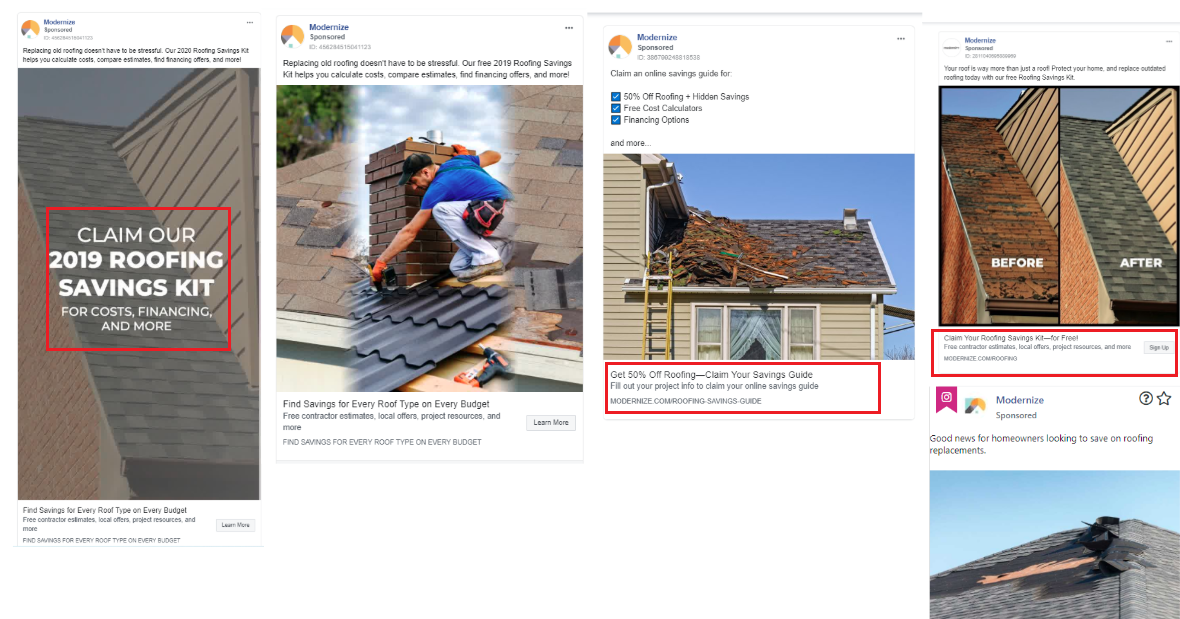
First off, the use of the word “claim” is particularly clever. Unlike “get”, “claim” implies ownership.
Modernize has made it sound like the potential customer is entitled to a “roofing savings kit”; that they have earned it.
Secondly, lead magnets work for a simple reason – people love getting free stuff! And, because it’s free, customers feel like they’re getting a sample of your service without any monetary risk. In fact, it will look like you’re doing the customer a favour without asking for much in return.
This kind of headline is obviously working for Modernize, so we can take a leaf out of their book. However, I would have a suggestion to make the headlines even better – without making them too wordy.
I would put a monetary value on the Roofing Savings Kit (i.e. worth $99). It’s a simple technique that will immediately draw the eye of your potential customer. As I said, people love getting stuff for free – and they especially love it if the free resource is expensive.
It also places on the potential customer a certain sense of responsibility. I.e. now that they’ve had the expensive gift for FREE, they’ll feel more obligated to use your service in comparison to another business, which gave them nothing.
The second set of headlines read: “Find Savings For Every Roof On Every Budget”.

This headline is more generic and doesn’t have the same “pull” as the lead magnet.
Still, the promise of being able to accommodate “every budget” is a comforting one – even though they don’t ask about your budget in the quiz (more about that later).
I would say that this is, by far, the less strong of the two headlines.
Verdict: I love the idea of a lead magnet, but a monetary value on there would see an even higher CTR. The other headline is generic and doesn’t do anything “different” with its hook.
Modernize’s Ad Copy
Modernize has a couple of ad copy variations, but I think they could do a few more.
The first reads:

“Replacing old roofing doesn’t have to be stressful. Our free 2019 Roofing Savings Kit helps you calculate costs, compare estimates, find financing offers, and more!”
They’ve mentioned the lead magnet again, which would certainly entice potential customers to click.
However, they’ve also forgotten to update the year. It’s only 2020 but, in the marketing world, 2019 was ages ago. It can be the exact same guide, but audiences don’t want to be given “old” or “outdated” information.
The list of the Roofing Kit’s features (help calculating costs, comparing estimates, etc.) touch and help to solve customer pain points. Re-roofing a house is going to be expensive, and any savvy customer is going to want to make the biggest savings they can.
That said, “replacing old roofing doesn’t have to be a struggle” isn’t the high-impact first sentence it could be. Again, it sounds generic – the same old line you’d trot out for any sort of problem.
The second set of ad copy reads:

“Claim an online savings guide for:
- 50% of roofing + hidden savings
- Free cost calculators
- Financing options
And more…”
Again, this tells you the benefits of the Roofing Savings Kit, but with very little fanfare.
In August 2019, Facebook made a big change to the aspect ratio for ads on the mobile News Feed. Instead of a 2:3 ratio, which allowed for 7 lines of text before “See More”, the new layout only shows 3 lines of text.
That means every word now counts. There can’t be any preamble – the ad copy has to grab the reader immediately, or it’ll get lost in the noise.
I usually start my ads by saying something that will hit one of my target customer’s biggest pain points. Or, I’ll start with something that will immediately cause a bubble of curiosity – anything that will get that click.
The reference to a lead magnet is good – but I think Modernize could write copy with more impact.
Verdict: Nice reference to the lead magnet, but they need to update their ad copy from 2019 to 2020. Modernize could definitely benefit from drafting more “3 line openers” to get potential customers hooked.
General Notes About Modernize’s Roofing Ads
Okay, so a few more notes before I go into the sales funnels.
First off, as I said before, the ads contain zero references to budget or any savings you can make.
Putting a specific number on a saving (i.e. 50% off or 0% interest financing) makes the offer a lot more concrete to interested parties. At the moment, there are just vague references to “savings” that mean very little.
Secondly, though the features of the lead magnet are listed on the ad, it doesn’t explain how the kit works. Is it a document? A website? Is it just something to read, or will there be phonecalls?
A few more details about the kit would be great – especially as not much is explained in the upcoming quiz.
I also had a look at Modernize’s other advertising channels. Although they’re advertising on Instagram and Google (not putting their eggs in one basket – good), they’re not advertising on YouTube.
No matter your niche, YouTube is a brilliant place to advertise. Not only is YouTube classified as a search engine, but it also comes second in popularity only to Google.
With 1.5 billion active users making 3 billion searches per month, you’d struggle NOT to find your ideal audience on YouTube.
I know YouTube ads can seem daunting, as they 100% rely on video. However, video is processed much quicker by the human brain than written text. It also allows businesses to form a closer human connection with their customer.
This elevates trust between the customer and the brand, leading to more and more sales.
I checked YouTube and Modernize do have a channel. They only have 147 subscribers, but their most viewed video comes in at a whopping 179k views.
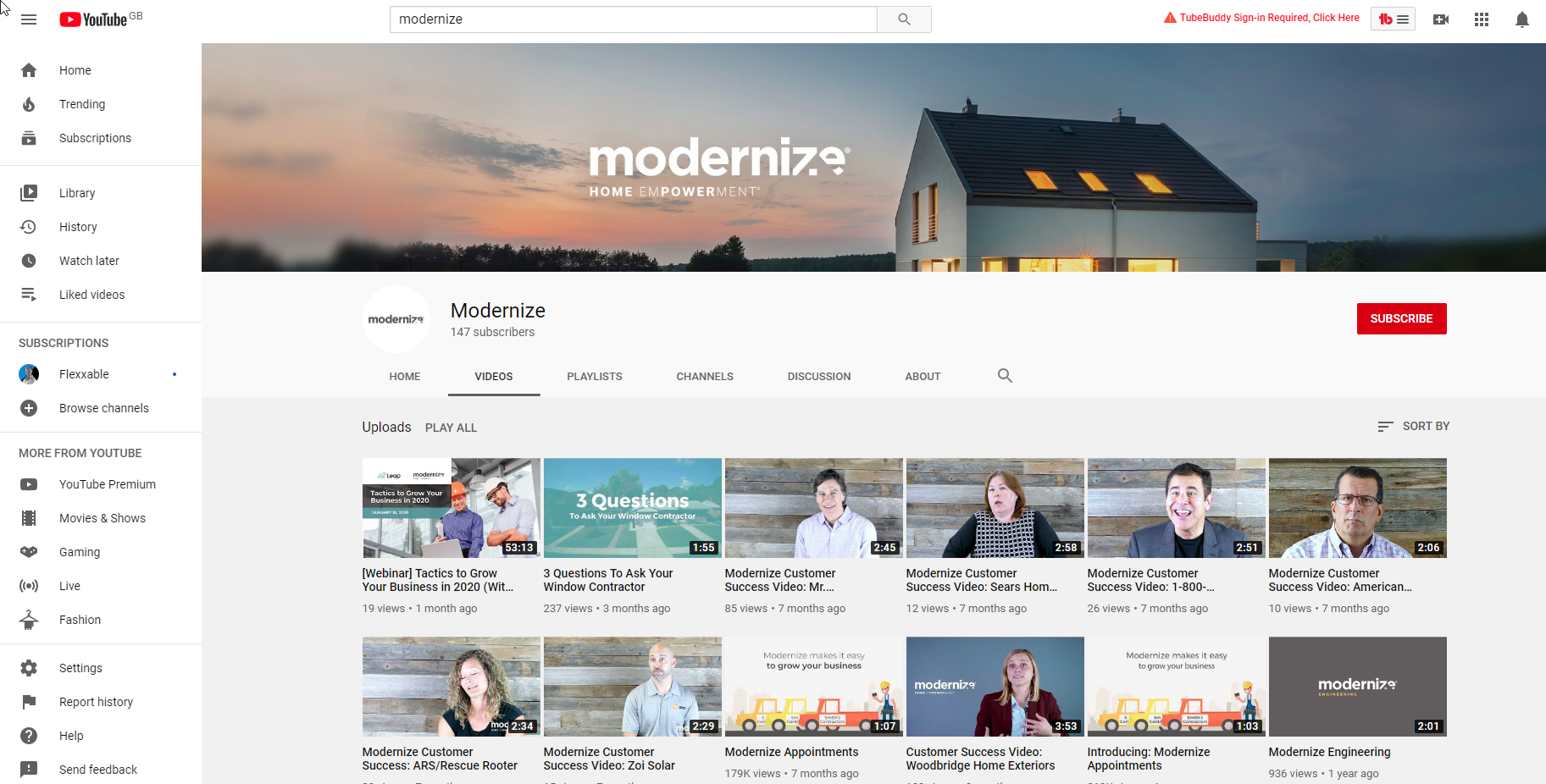
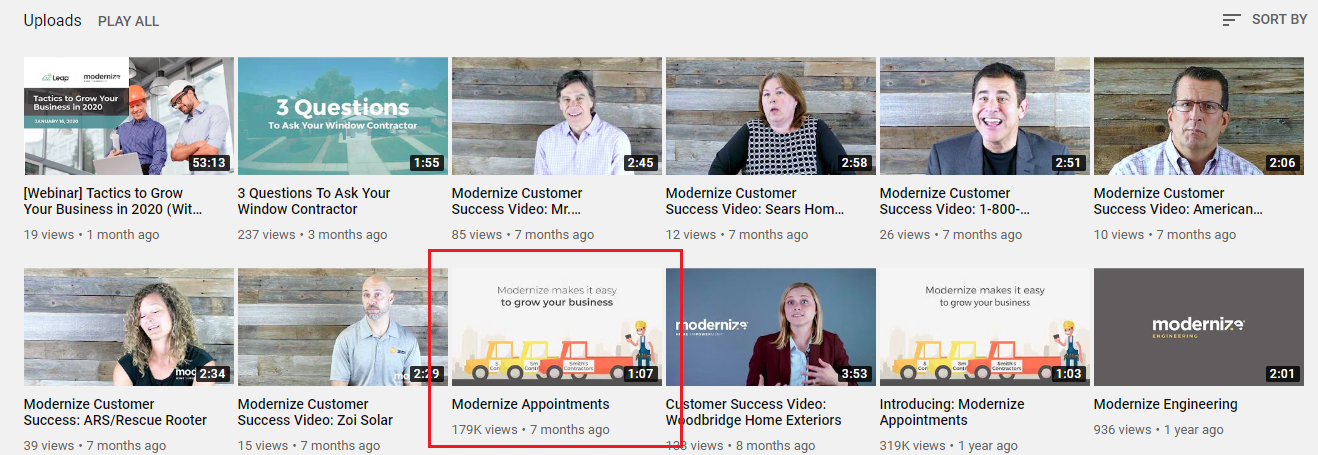
This proves that video ads could summon a big audience – if only they used the opportunity.
I’m going to talk to you more about YouTube TrueView advertising in your niche later on in the article.
|
Don’t forget that part of my Pay Per Lead Quick Start Guide contains the same YouTube ad script template I use for my ads at FlexxDigital. These ads have had thousands of views, with one of our best performing ads racking up 1.4 million. We don’t use any fancy gimmicks – usually, it’s just a white background with an actor talking directly to the camera, and graphics laid on top. You can create YouTube ads just like ours, with our template ad script. Get your copy now, by clicking the button below:
|
[maxbutton id=”1″ extraclass=”quickstartguide” ]
Verdict: I think Modernize has done a fairly good job. However, with better ad images and by focusing on those first 3 lines of ad copy, they could reduce their Cost Per Lead (CPL) by as much as 25%-50%.
They should also make the most of their high viewership by investing in YouTube ads. The targeting opportunities aren’t to be missed, and creating ads doesn’t have to break the bank.
Modernize’s Sales Funnel
Modernize’s Advertorial
Once you’ve clicked on the ad’s CTA, Modernize takes you through to an advertorial.

I’ve spoken in previous posts about the power of using an advertorial in a sales funnel, so I won’t dwell on that too long in this post.
The key point is: the ad gets curiosity-driven clicks while the advertorial does the selling.
As we can see, Modernize have stuck to the “golden formula” for an advertorial pretty well: about 70% is useful content with the other 30% consisting of service promotion.
The headline generates pure curiosity: “Homeowners with Outdated Shingles in for Big Surprise”.
The image underneath shows us a colour-coded map of the US (though what the colours represent are unclear), with the proclamation: “Save $1000s on a new roof”.
This is the first time Modernize has hinted how much you can save on roof replacement or repairs, with the mini-CTA: “See If You Qualify. GET ROOFING ESTIMATES”. They then ask for the visitor’s Zip Code.
Underneath, Modernize explains how a new roof can save $100 on utility bills, and increase the value of your home by up to $14,000.
As advertorials go, it isn’t a particularly long one: roughly 350 words. However, that’s not to the advertorial’s detriment. Modernize quickly aggravates and solves a customer’s biggest pain point – whether it’s financially “worth it” to invest in a new roof for the long term.
If they’ve targeted their ads correctly, Modernize should be looking at a click-through rate of 20%. So, about 100 clicks on Facebook should result in about 80 people making it to the advertorial.
Out of that 80, roughly 16 people will click onto the quiz and, after that 4 or 5 will become leads.
That doesn’t sound like many, but the aim is to get thousands of people clicking on your ads every day. If 1000 people click the ad, that will result in about 40 – 50 highly qualified leads (as they’ve gone through both an advertorial and a quiz).
If the leads cost $20 each, that’s $1000 worth of leads in a day (and that’s small-scale).
$20 a lead is nothing in comparison to the thousands of dollars a customer will potentially spend on a roof.
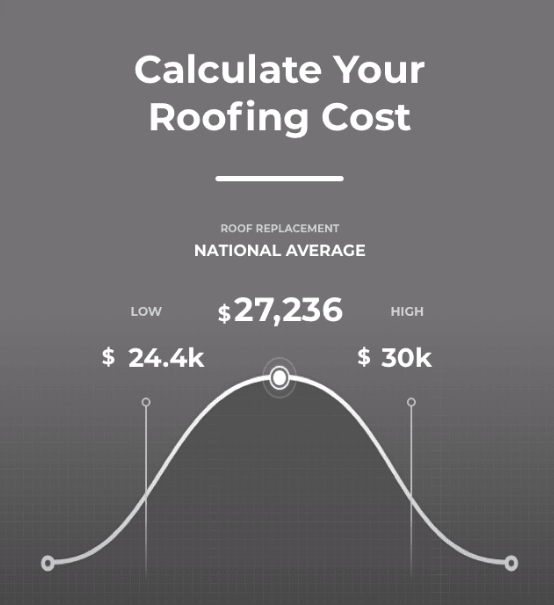
If they want their advertorial funnel to do really well, Modernize should consider driving traffic from Twitter, Taboola or Outbrain.
Twitter responds particularly well to advertorial funnels – far better than Facebook. As 71% of Twitter users go onto the platform to read the news, you’ll find them more receptive to clicking links that take them off the site and onto long-form content.
It also means you can get away with more “clickbaity” headlines than the ones that get through Facebook’s ad policy. Such headlines drive people to make that click onto another site, without feeling resentful that they’ve left the social media platform.
Plus, an advertorial with a “newsworthy” story or super-useful content is more likely to be seen as a “reward” to the curious or the highly-educated.
I’ve already spoken about the segue from advertorial to quiz (“Don’t Get Ripped Off”), so we’ll move straight onto the quiz itself.
Modernize’s Quiz Funnel
After clicking “Get Started”, we’re taken onto a minimalist quiz page, with the title “Claim Your Roofing Savings Kit For Free!”
Again, there’s no further information about the savings kit or how it works, but the page remains uncluttered.
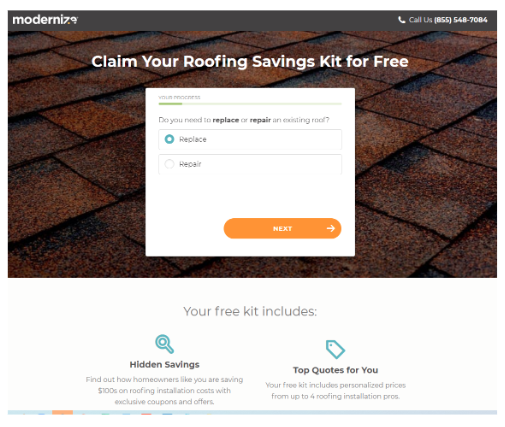
I think this page looks pretty good. They’ve stuck with stock images, but the tile pattern doesn’t distract from the quiz.
The page is also less than 1mb in size and mobile-friendly, which is incredibly important for lead gen. With 57% of the world’s website traffic coming from mobile, neglecting smartphone optimisation is like depositing cash straight into your competitor’s bank account.
Even more significantly, 88% of mobile users access Facebook using their smartphone. If Modernize didn’t optimise for mobile, they could lose thousands of potential customers.
The first question is nice and simple, just asking for a Zip Code. This doesn’t overtax the visitor, and it ties in with Modernize’s promise to supply local installers, wherever you’re based.
The next question again keeps it simple:
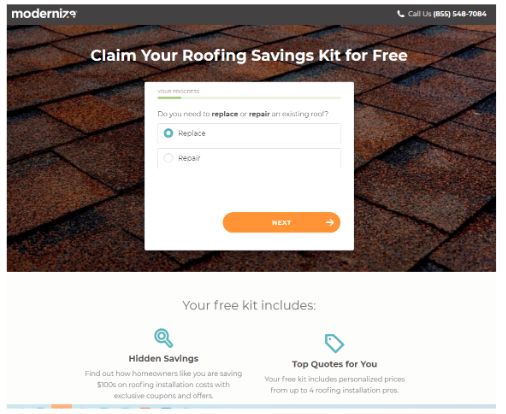
The quiz is encoded not embedded, meaning it loads very fast. Statistically, a page that takes longer than 2 seconds to load will lose 7% of conversions, with 40% of visitors abandoning the site if load time is longer than 3 seconds.
After a dig around, I could see that Modernize is using:
- VWO (an experience optimisation platform that improves key business metrics)
- Heap (captures web and mobile app behavioural data)
- Blue Triangle (which helps slow web performance)
All these tools indicate that Modernize is paying a lot of attention to the percentage of people who hit the landing page.
Unfortunately, according to GTMetrix (a site performance analyser), Modernize’s quiz took 4 seconds to load – almost twice as long as the recommended limit.
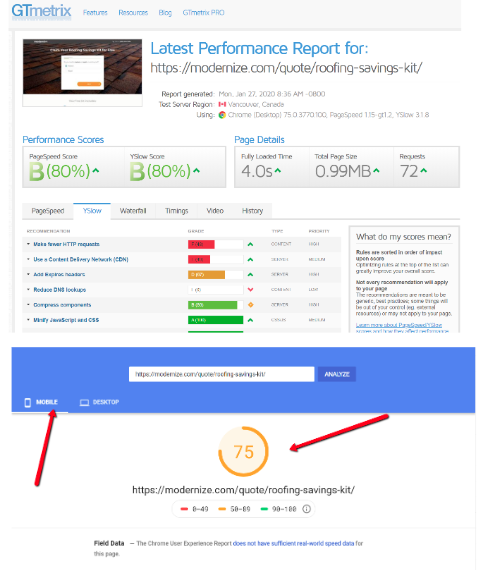
The Google Tag Manager is loaded with all the ad network-scripts, which is ultimately damaging the overall load speed. It would be quicker if they had one page per traffic source, but there’s not much you can do about network-scripts.
Ironically, Blue Triangle, the tool for increasing website speed, is the slowest script to load. If the tool isn’t working, it’s worth letting it go.
Finally, the image of the shingles in the background isn’t compressed. If Modernize compressed the image, they could probably save the load speed by up to a second.
I’m going to go through the rest of the funnel super quickly.
Modernize asks whether you’re looking for replacement or repair, then asks what the roof should be made of.
Once I’ve answered both questions, I’m asked for my street address (so they can recommend local businesses), name, then my email and phone number.
From the way the quiz works, I can see that Modernize want me to give my address and telephone number before I get my Roofing Saving Kit.
Logically, this makes no sense.
To get the most out of a potential lead, you have to ask them to make micro-commitments, one step at a time.
If Modernize promised the Roofing Saving Kit in exchange for an email address, then promised a free call with an expert afterwards, in exchange for a phone number, that would have worked.
At this point, however, I’m considering dropping from the funnel, and I’m not even a real prospect.
Essentially, if Modernize had put the email address and phone number on separate pages, they could have used two pixels. They would pick up all the data from those who dropped out after the email address and add them into a nurture sequence.
After I put in my (fake) name and address, the results page comes up with “Here are your results”
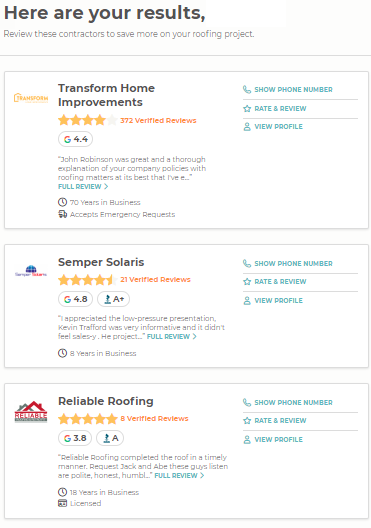
The page is uncluttered and I apparently have three results from companies that can help me out.
Again, I haven’t been asked about my budget, which was a pretty big selling point in the ad.
The results page doesn’t actually give me the option to schedule an appointment with either of the roofing companies but, as they have my (fake) phone number, I assume one of them will follow up shortly.
Unfortunately, I have to wait over six hours to receive my lead magnet via email.

As you can see, the lead magnet contains an estimate of what my roof will cost based on the national average.
The email is nicely laid out, looking very slick. It includes the financial calculator promised, plus “2-4 quotes INSTANTLY from pros in your area” in the following categories:
- HVAC (Heat, Ventilation and Air Conditioning)
- Roofing replacement
- Solar installation
- Windows replacement
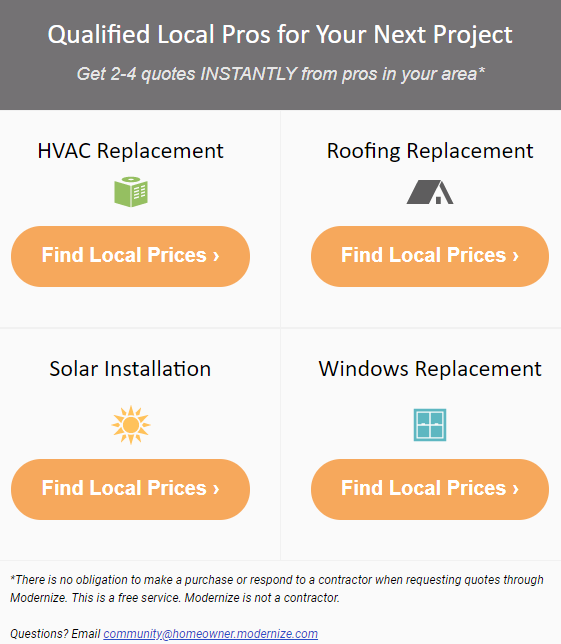
Shortly after, I receive an email. It says that one of my results, Dr Roofs, will be calling me soon.

Followed by another email from Reliable Roofing:
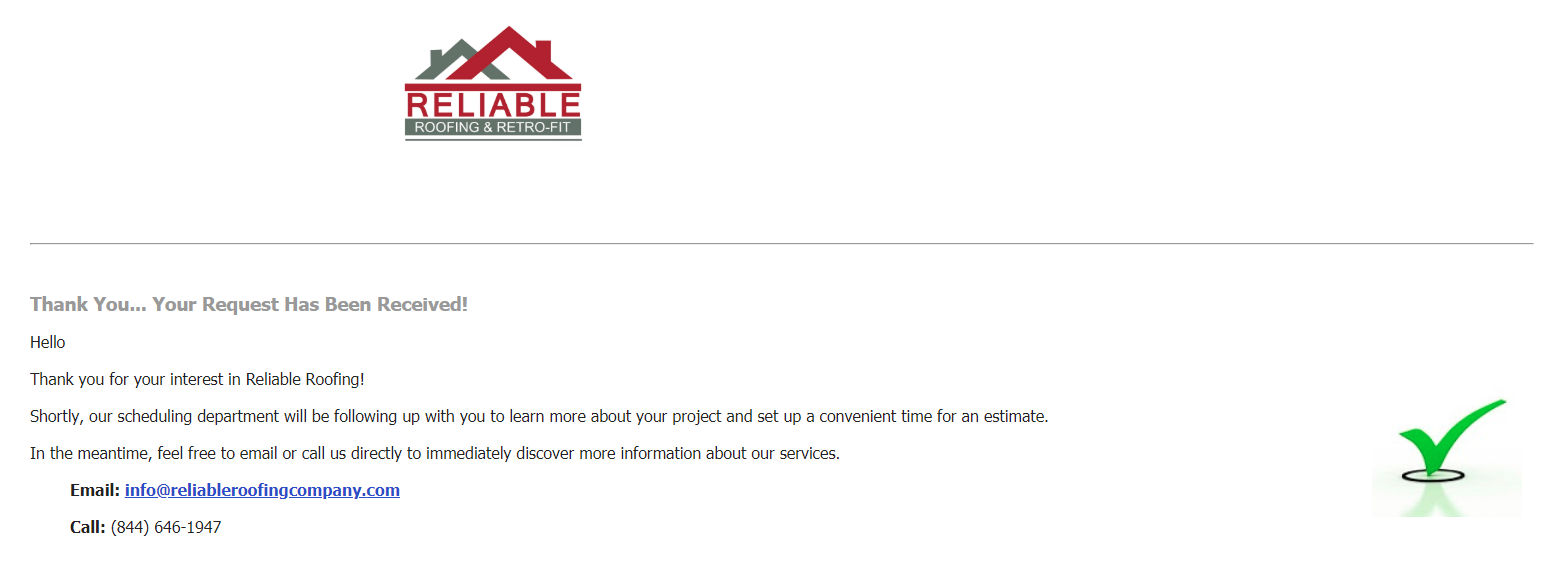
And another from Home Advisor:
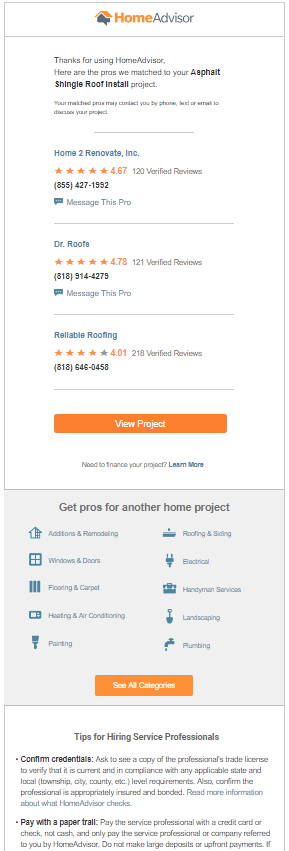
Despite the initial wait, I’m impressed with the email follow-up from the various roofing companies.
So, now we’ve been through Modernize’s entire sales funnel, let’s weigh up the pros and cons.
Modernize’s Sales Funnel: Pros
1. The “Claim Your Roof Savings Kit”. A lead magnet is an excellent way of getting more customers to trust you, as well as familiarise themselves with your brand. As I said before, people love getting free stuff – and something as simple as a well-designed email shouldn’t break the bank.
Modernize also don’t use buzzwords like “government incentive” or “insurance”, meaning the quality of the overall leads should be higher. These are people genuinely in need of a new roof and have the money to pay for one. Anyone attracted to “government incentives” don’t tend to have the money to pay for a high-ticket service like roofing.
2. The mobile-friendly quiz. The quiz looked great on mobile, though the load-speed let it down. With such a great looking, easy to use quiz, Modernize are well aware that 57% of the world’s traffic comes from mobile.
3. The email responses. Though the lead magnet came far, far too late, I was impressed with the three emails telling me about upcoming sales calls. All of these kept it simple and offered me the chance to get in touch first.
4. The layout of the (eventual) Roofing Savings Kit. It took a while to come through, but the Roofing Savings Kit could prove genuinely useful to someone who needed estimates on roofing repairs and replacements.
Modernize’s Sales Funnel: Cons
1. The hooks aren’t great. I really liked the hook “Don’t Get Ripped Off”, but it came too late in the funnel.
The problem is, Modernize just assumes that everyone is looking to buy a new roof. There’s nothing wrong with that, per se, but it cuts out a lot of people who would benefit from a new roof but haven’t yet thought of getting one.
Modernize could open up their funnel by adding hooks like:
- “Could you be scammed by a Roofing Contractor?”
- “Does your roof have these three telltale signs it’s about to fail?”
These are curiosity-driven hooks that’ll entice clicks from people who’ve never really thought about their roof before.
I suppose, in Modernize’s defence, they want to avoid possible time-wasters. Advertising to those with the assumption they want a roof just cuts out the tire-kickers.
That said, “Find Savings For Every Roof On Every Budget” is beyond overdone and snore-worthy. It cuts straight to the chase, sure, but it doesn’t fire up the imagination.
On a similar level, “every budget” rings hollow. Neither the advertorial nor the quiz mention budgets, or even ask you how much you’re willing to spend.
The lead magnet tells you how much the “average cost” is for your kind of roof but, by then, it’s too late. If a guy wildly under-estimates how much his new roof will cost, Modernize’s clients will waste valuable time chasing leads that can’t convert.
2. They don’t specify how much you can save. “Find savings” is all very well and good, but it reads like an empty promise.
Put a number on your offer, if you can be specific. I know that Modernize work with loads of contractors, so a blanket “50% off” deal won’t work.
However, there are ways around that.
Plenty of companies use testimonials or examples to show how the service benefits the customer. For example, “The average American homeowner saved $4327 with this Roofing Savings Kit”.
This provides a concrete idea of the savings you can make and offers social proof. Far less wishy-washy than just “Save Money Today”.
3. They could make the “segue” smoother. Gary Halbert wrote about segues in the famous “The Gary Halbert Letter.”
This is what he says:
By the way, if you are not familiar with the word “segue” here is the dictionary definition, “to move smoothly and unhesitatingly from one state, condition, situation or element to another.” For our purposes, a segue is simply a slick way of capturing someone’s attention which makes it possible for us to make a logical and seamless transition to the really important message (why they should buy something from us).
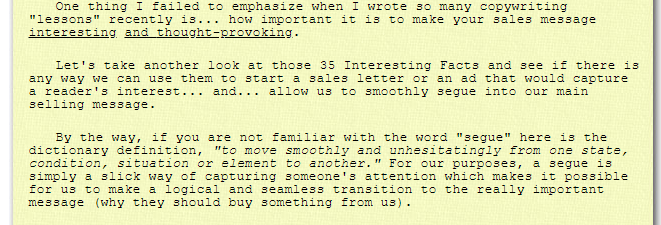
Applying that theory to Modernize’s sales funnel, you can see what they’ve tried to do.
From the advertorial onwards, Modernize has told us how we can save money on utility bills by investing in a new roof or roof repairs.
The company then warns us “not to get ripped off” before we’re directed towards the quiz.
However, the transition between “Find Savings For Every Roof On Every Budget” to “Cutting Utility Costs by $100s” to “Don’t Get Ripped Off” feels incredibly fractured.
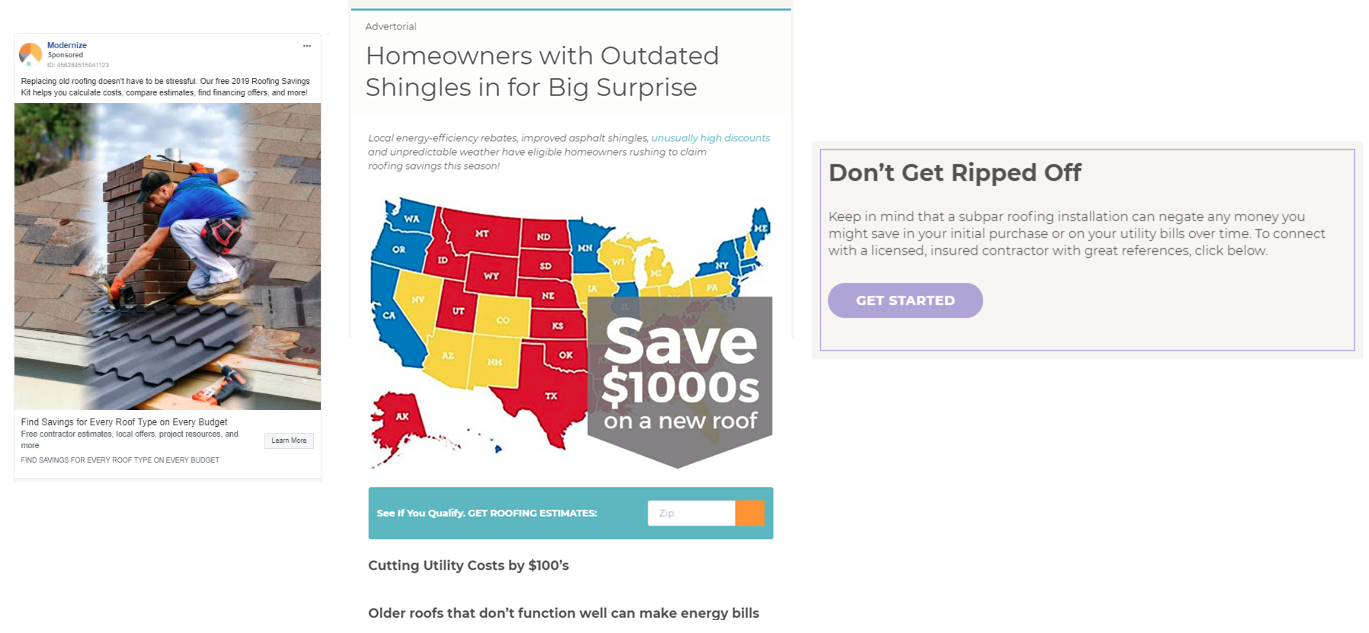
If the ad hook was better (see my examples above), you could seriously play on customer pain points and curiosity before transitioning to the offer. As it is, it feels like Modernize has mashed three hooks into one, and not aced any of them.
4. They don’t make use of YouTube. Although Modernize has a great presence on Facebook, Instagram and Google search, they’re missing a trick with YouTube.
As I said before, they already have a YouTube channel. I think with YouTube, you can make a B+ sales funnel (like Modernize’s) and make it into an A+.
Which leads me to the second part of this post: using YouTube effectively in your sales funnel to generate the maximum amount of leads.
Using YouTube In Your Sales Funnel
As I said previously, YouTube is the second biggest search engine on the planet – so it can’t be missed when you’re running ads for your clients.
Here are a few quick stats about the platform:
- YouTube is actually classified as a search engine, and its popularity is second only to Google.
- It has 1.5 billion active users
- Users make about 3 billion searches per month (that’s more than Bing, Yahoo, AOL and Ask.com combined!)
- 300 hours of video are uploaded to YouTube every minute
- YouTube streams 1 billion hours of video to users every day.
If stats like that don’t get you excited, you’re probably in the wrong business.
But I do get it. YouTube advertising can seem daunting, especially since it 100% relies on video.
Here’s my #1 suggestion (not a tip!): just give it a go.
Video is processed by the brain much quicker than written text, and it allows businesses to form a closer human connection with their customer. This elevates trust between customer and brand, leading to more leads and more sales.
Bottom line: take the hint from your competitors. Your Pay Per Lead agency will suffer without a video advertising component.
What YouTube Ad Style Should I Opt For?
1. Preroll
2. Bumpers
3. TrueView
You’ve got three key types of YouTube ad:
- Preroll
- TrueView
- Bumpers
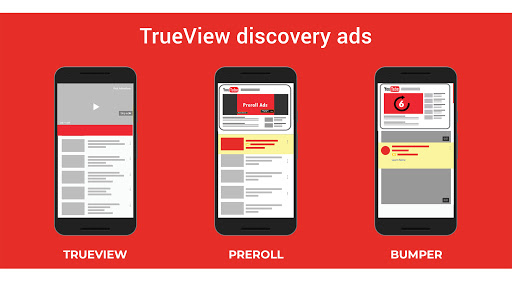
Preroll
Preroll YouTube ads are non-skippable ads that make people watch them until the bitter, bitter end. They can turn up before, after or halfway through the visitor’s chosen video.
As of January 2018, preroll YouTube ads have a time limit of 15-20 seconds.
Preroll ads have their pros and cons, like all forms of advertising. On the one hand, these ads get the best engagement rate of all YouTube ad forms (mainly because the viewer has no choice).
On the other hand, there’s also a higher video abandonment rate.
If you choose to use preroll ads, make sure your story is TIGHT. 20 seconds is long enough to have characters, dialogue, and build brand awareness. Make sure you include a call to action and give your viewers something to click.
Bear in mind that YouTube’s preroll videos are charged on a PPC (pay per click) basis. A crappy landing page beyond the YouTube ad could waste a hell of a lot of money.
Bumpers
Bumper YouTube ads are the shortest of all the ad styles. At a mere 6 seconds long, they’re non-skippable and play before the viewer’s chosen video.
If you want to use bumper videos, I highly recommend you use them as part of a larger video campaign. With the correct targeting, your audience will hopefully see a mixture of your TrueView, preroll and bumper ads.
Bumper ads are all about brand-awareness. Get your logo up there, and make sure you’ve got one hell of a tagline.
TrueView
TrueView ads are the standard on YouTube, and the type we use at Flexxable and Flexx Digital.
YouTube doesn’t have a strict time-restriction for TrueView ads, so they can last between 12 seconds and 6 minutes in length.
That said, viewers have the option to skip a TrueView ad after 5 seconds. So, if you want to get their attention, do it quickly.
However, the great thing about TrueView is that you only pay when viewers watch or interact with the ad. For example, if a viewer chooses not to skip after 5 seconds, but skips after 10, you won’t pay anything.
YouTube only counts the ad as “watched” after a full 30 seconds or until the advertisement reaches the end. You’ll also pay if the viewer interacts with your ad, such as clicking on a link. Again, make sure that click is worth it for the user.
In my opinion, TrueView ads are the way forward and an essential feather for any serious lead generator’s cap.
And YouTube ads don’t have to be needlessly complicated. Next, we’re going to look at writing a YouTube script.
Your YouTube Ad Script
3. Section 3 – Why Am I A Credible Speaker?
Here’s a quick run-down on how to piece together your YouTube script. Having a great script is the no.1 way to cut your cost per lead on YouTube.
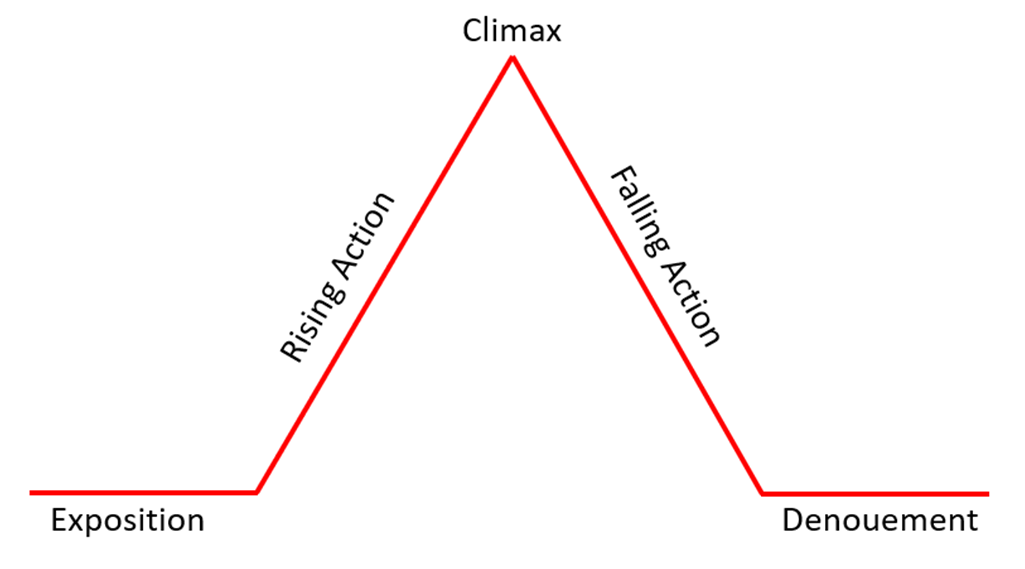
Section 1 – Your Hook.
You need to call out your audience from the very beginning. This could be something as simple as asking a rhetorical question: “Are you a [man/woman/dad/mum] who’s tired of [being in debt/expensive car insurance/waiting decades to pay off your mortgage]?”
Using “tired of” or “fed up of” feeds directly into the emotional mindset of your audience. If they’re not “fed up” then that ad’s not for them. No biggie!
Section 2 – Build Emotion.
Talk about the audience’s critical problem – and make sure it’s only one. If you try and take on too much in one vid, you risk confusing your audience.
Shoot straight to the heart of the matter: “The biggest problem a lot of [men/women/mums/dads/etc.] face is [insert their critical issue]. Expanding on their problem also provides context for the viewer.
Section 3 – Why Am I A Credible Speaker?
What gives you the right to speak on the topic?
Have you been through the same problem yourself? Are you an “expert” in the field?
If you choose the “expert” route, please make sure you either are or hire an actual expert. Audiences don’t appreciate being lied to, and a quick Google search will uncover your credibility (or not).
You can also drop your brand name at this point. I.e. “[YOUR BRAND] has helped thousands of [women/men/dads/mums] out of [KEY PROBLEM].
Section 4 – Solution.
How can [YOUR BRAND] help that person right now?
It’s important not to expect too much from your audience at this point. If your product/service costs a lot of money, a two-minute ad isn’t going to persuade them to take the plunge.
Start off small with a quiz, asking for their details, and promise them a free gift in return: “We created this [FREE TOOL] that will show you how to [INSERT DESIRE]”.
Section 5 – Call To Action.
It’s the end of your story, but it’s not the end of theirs. Ask your audience to “complete their story” by encouraging them to click the link/give their details/arrange a phone call. Make it sound like the solution to their biggest problem is within arm’s reach. Remind them that, if they’re still watching your video, they need your solution. Your viewer needs to feel a strong sense of investment.
|
Still unsure where to begin? Not to worry, our Pay Per Lead Quick Start Guide can help. This package contains the same YouTube ad script template I use for my ads at FlexxDigital. These ads have had thousands of views, with one of our best performing ads racking up 1.4 million. We don’t use any fancy gimmicks – usually, it’s just a white background with an actor talking directly to the camera, and graphics laid on top. You can create YouTube ads just like ours, with our template ad script. Get your copy now, by clicking the button below:
|
[maxbutton id=”1″ extraclass=”quickstartguide” ]
Once You’ve Got Your YouTube Ad Script
1. Hire Actors Directly – There’s No Need For Agencies
2. Be 100% Clear And Honest About The Role Description
3. Local Acting Groups on Facebook
4. Use Fiverr
The creative isn’t just down to a rockin’ good script.
For every video, we hire at least two to three actors that will appeal to our audiences.
We ask every actor to read from the same script, then we edit it into our YouTube ad. It all comes down to split-testing.
The results may surprise you. For one of our YouTube ads, we were sure that a white woman in her mid-forties would be the most popular with our audience. However, the ad that worked best was a black woman in her late-thirties.
Here are my top tips on hiring actors.
Hire Actors Directly – There’s No Need For Agencies
Unless you’re trying to work with acclaimed talent, there isn’t much need for you to approach talent agents. There are several ways you can find actors without running casting sessions or working with agencies.
Be 100% Clear and Honest About the Role Description.
We work in a few industries, including the financial services sector. This can mean we make adverts about delicate subjects, such as offering debt services. Some people may feel uncomfortable filming this kind of content, so you need to make the topic clear from the outset.
Local Acting Groups On Facebook
Facebook has hundreds of local and national actor groups. Likewise, you will find filmmaker groups populated with fresh talent as well as seasoned pros.
Facebook is an excellent place to find local talent, cheap studios and production companies to work with.
Use Fiverr
Fiverr is an excellent place to find actors without breaking the bank.
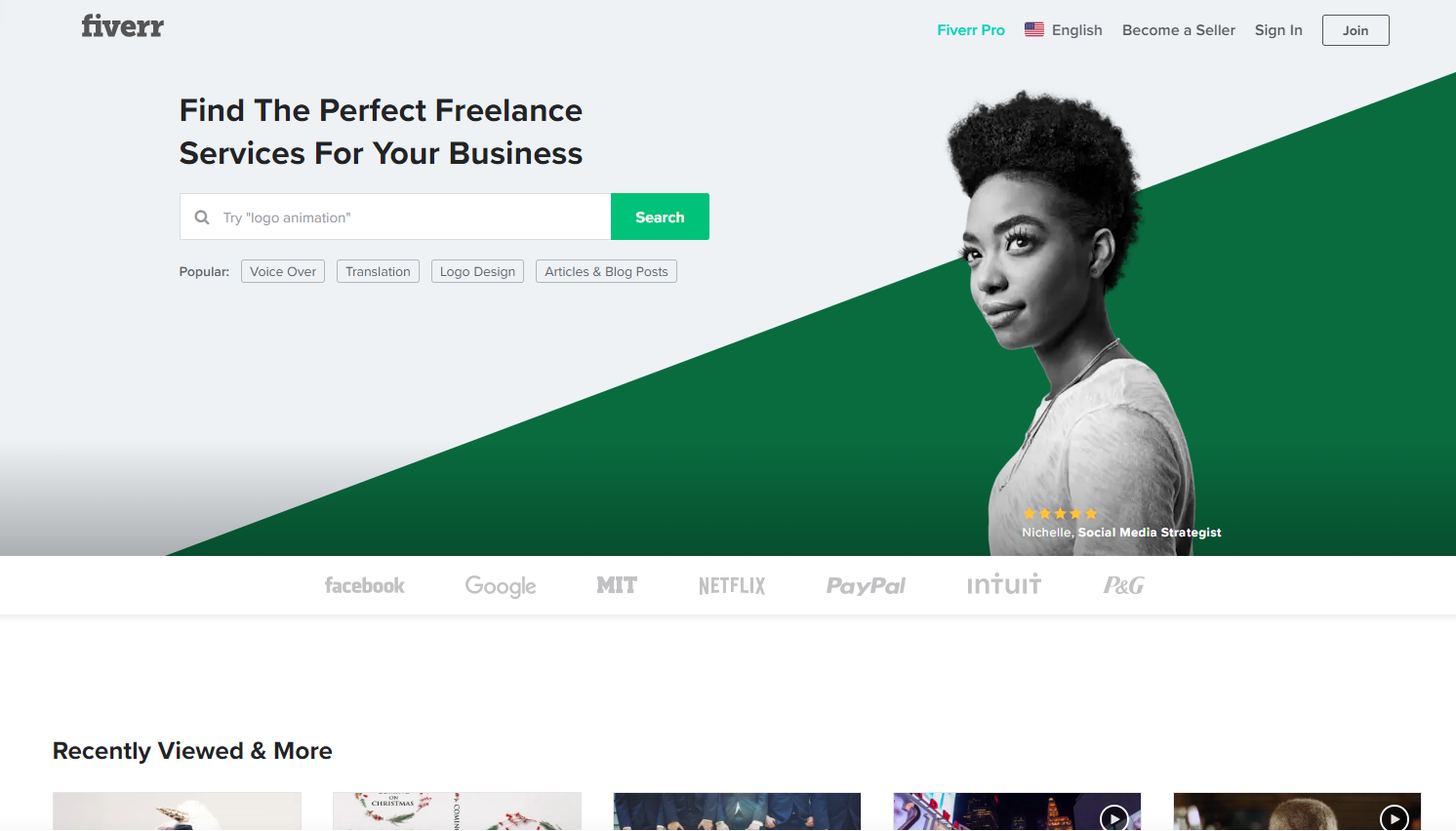
You can post a job on the site, and it’ll be up to the actor to provide the lighting, microphone, backdrop, and all the difficult stuff.
And, 9 times out of 10, the entire project won’t cost you anything more than $20-$50.
Targeting Your YouTube Ads
You can cut your cost per lead on YouTube by correctly defining your audience targeting.
AdWords has a tonne of audience targeting methods to use on YouTube. You’ve got:
Demographic groups: You can choose the age, gender and household income of your audience.
Detailed demographics: These are additional traits you can choose from, including whether or not your audience consists of students, homeowners, or new parents.
Interests: This gives you the power to advertise to people who’re interested in specific issues, even when they’re visiting pages about other topics.
Affinity audiences: YouTube gives you the option to target people who already have a keen interest in your ad’s key topic.
Custom affinity audiences: Ever made a custom audience on Facebook? This targeting method allows you to get much more granular with your targeting. For example, if you’re advertising car finance, you could reach business owners looking to lease a company car.
Life events: Want to target audiences that have just got married? Or people who’re heading towards retirement? Life events targeting will let you do that.
In-market audiences: Want to target people who are actively searching for products or services that are just like yours? You may want to look at your in-market audiences.
Custom intent audiences: This is where viewers begin to question “can advertisers read my mind?”. Custom intent audiences allow you to advertise to people who’ve recently searched for similar keywords on Google.com.
Topics: This method will allow you to target audiences interested in specific topics. For example, if you target “Writing and Editing Services”, your ad will show on YouTube to people looking up videos about copywriting.
Devices: You can target users based on their use of devices, such as smartphones, laptops, and Chromecast.
How granular you want to get with your targeting depends on how much you’re willing to pay for that click. If you’re advertising to a vast audience, you may see your YouTube cost per lead spike before the Google algorithm sorts itself.
If you’re targeting a hyper-granulated audience, be aware that your cost per lead may spike over time, as Google searches for audiences that suit your targeting.
Custom Affinity and Custom Intent audiences are very powerful, here. Much better than Facebook. We can target roofing websites, competitors, people who are searching for roofing etc.
This is what a custom intent audience looks like:
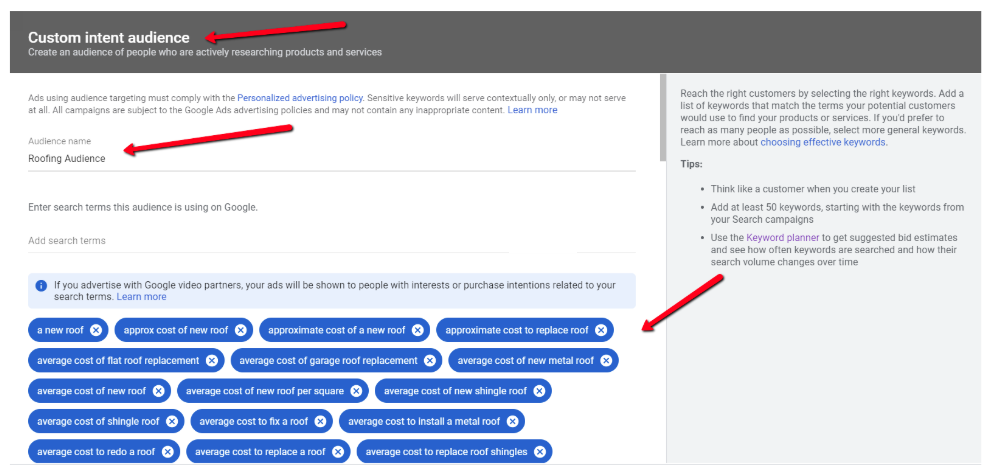
The lead cost may be a touch higher, but the quality is going to be better. People will be educated and informed by your YouTube video before clicking over to the website and the rest of your sales funnel.
Once you’ve got your YouTube ad up and running, simply link it to your quiz – the same way you would an ad to advertorial to quiz funnel. Because the audience have been educated by the video, I guarantee engagement will be off the charts in comparison to Facebook.
Now You Try It
Reverse engineering is an amazingly powerful strategy if you want to start competing with the “big boys” quickly.
As I’ve said, there’s no need to “reinvent the wheel” when it comes to building your sales funnel. Quite often, there’s something working brilliantly out there – and all you need to do is find it and make it work for you.
But nothing is ever perfect. Even those people who are smashing it out of the park can make improvements.
I mean, Modernize obviously has some smart developers and coders sitting behind their sales funnel. It’s pretty slick, and most people reading this post won’t have the luxury of access to that stuff.
However, where there’s a will, there’s a way. Software like LeadsHook can build an amazing quiz, without the need for any coding experience whatsoever.
Likewise, drag-and-drop website builders like Unbounce can create landing pages and advertorials that look as professional as ones built with coding and CSS.
(Quick PSA: click to get your FREE Unbounce trial, plus 20% off for the first three months.)
However, Modernize falls down when it comes to creative. I have said before that creative will always be king when it comes to ads, and those who acknowledge that will have for more success than if they just rely on media buying strategies.
Modernize have also missed a trick when it comes to advertising networks like YouTube. As a result, they simply can’t be making the money that matches their potential.
So, my point: when looking at a competitor’s sales funnel, keep an open mind. How could it be improved? Are they (intentionally or unintentionally) missing out on a large part of their potential audience?
Are they advertising on all platforms, or leaving all their eggs in one basket?
I’ve used roofing as an example here, today, but you can apply reverse engineering to any niche under the sun.
Reverse engineering can take as short or long a time as you’d like, depending on the level of detail you’d like to go into.
Personally, I think all the analysis work is worth it. You get out what you put in, and only a deep understanding of your niche and competitors will propel you to the top.
|
So you don’t get overwhelmed, I have put together a special bonus package for you, which you can download immediately. It contains: 1. A cold email template to land national-level clients in your niche 2. The exact YouTube ad script template I use to drive millions of views and thousands of leads at FlexxDigital. Just click the button below to get your Pay Per Lead Quick Start Guide now!
|
[maxbutton id=”1″ extraclass=”quickstartguide” ]
Now I’d like to hear from you.
Have you been having trouble building your sales funnels for new clients?
How helpful do you think reverse-engineering is, really? Do you think taking inspiration from your competitors can help you get to the next level?
Tell me all by leaving a quick comment below.





